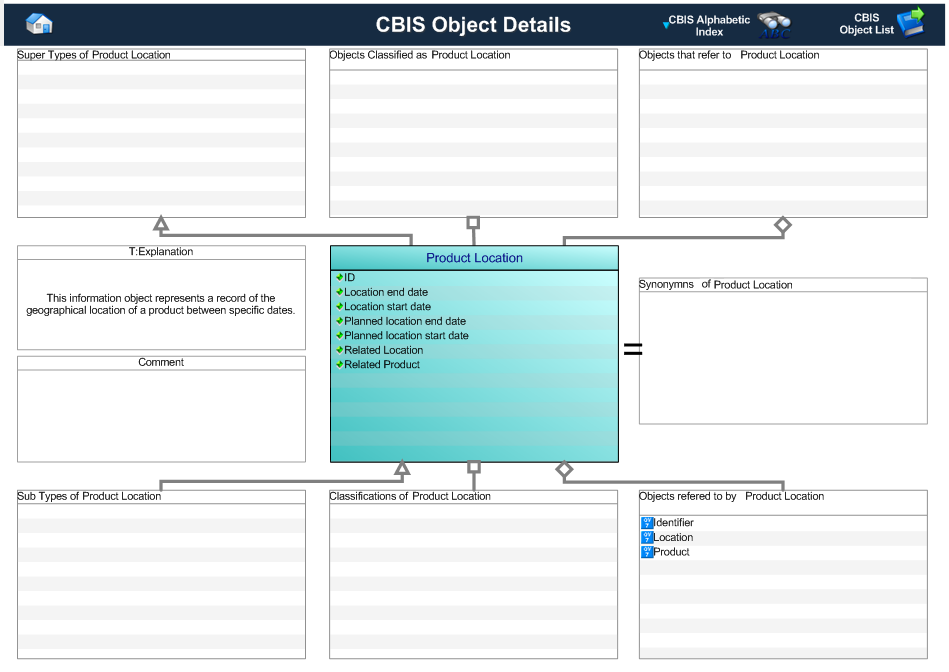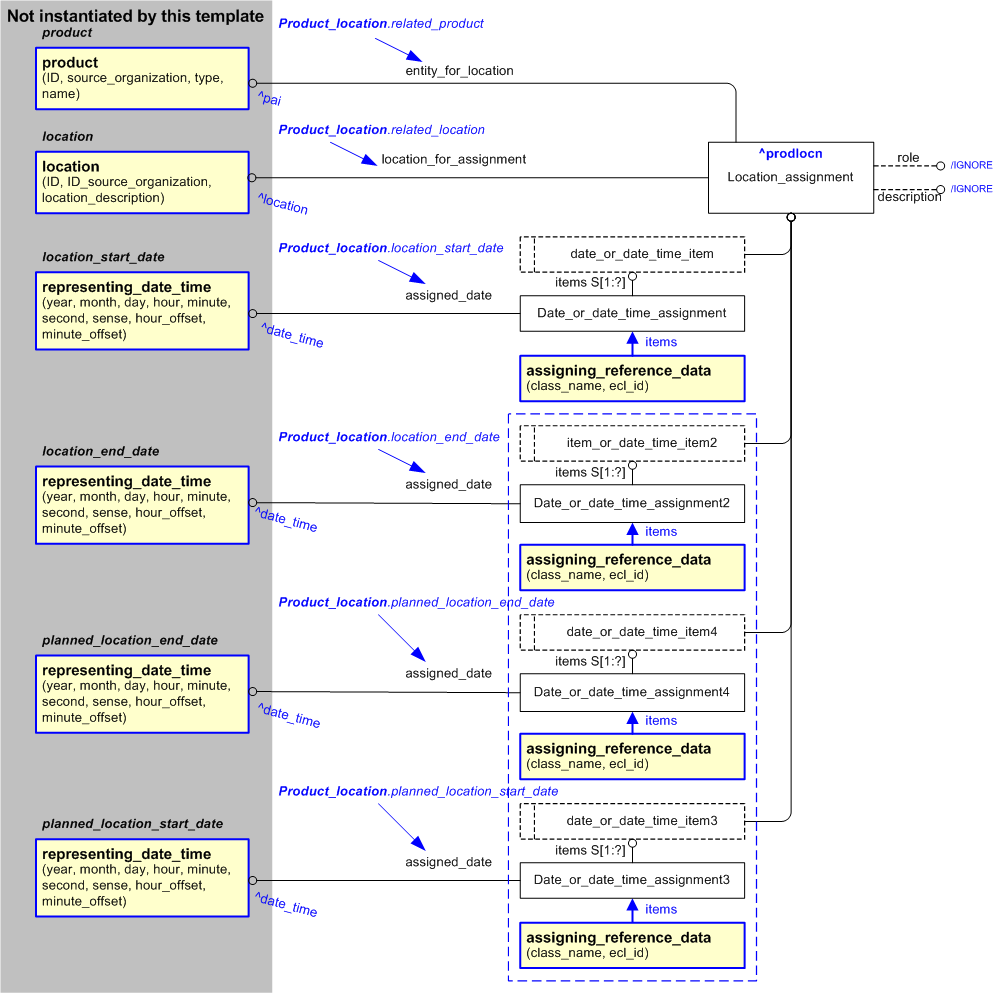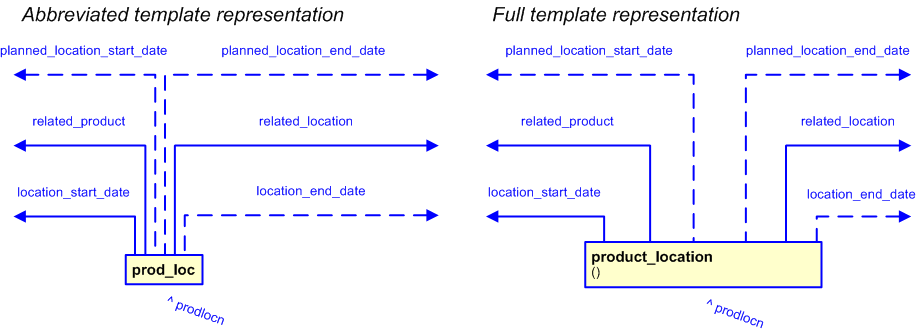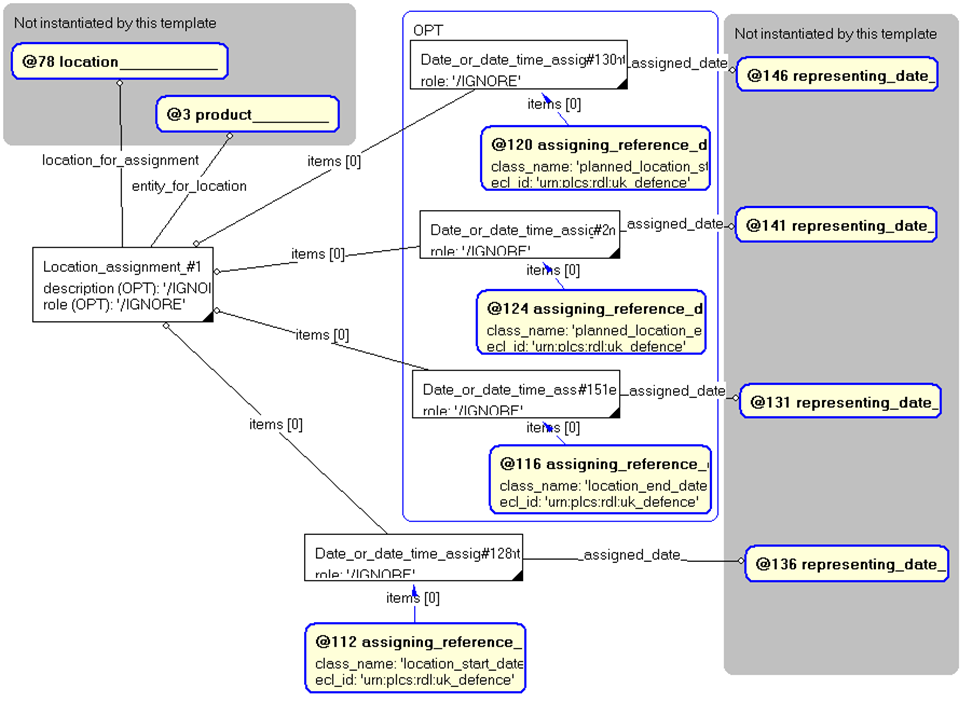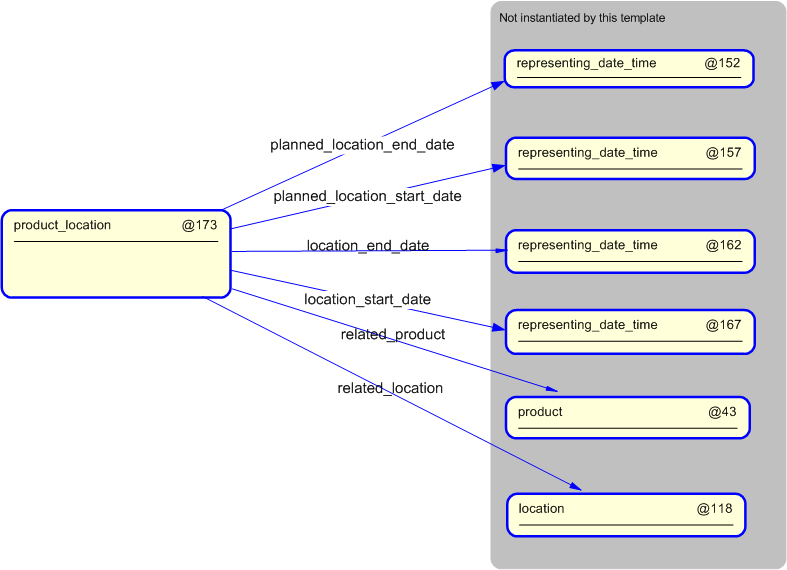Template:— product_location (prod_loc)
Context:— UK_Defence |
Date: 2010/03/18 12:28:57
Revision: 1.5
|
This section specifies the template product_location.
NOTE
The template has been defined in the context of
UK_Defence.
Refer to the business context for details of related templates.
NOTE
An explanation of a template and the associated instantiation path is
provided in the
Template overview
section.
This template describes how to represent a record of the geographical location of a
product between specific dates.
The Product Location business object is used by those UK_Defence Data Exchange
Specifications to represents the geographical location of a
product between specific dates.
Figure 1 — Graphical Representation for Business Object Product Location
Product Location
The definition of a Product Location object is:
This information object represents information about the geographical location of a
product between specific dates.
|
Attribute name
|
Attribute description
|
Attribute type
|
Optionality
|
| ID |
This is the identifier of the Product Location. Note: not mapped; see issue log |
Identifier |
Mandatory |
| Location end date |
The date on which the related product ceased to be located at the related location. |
Intrinsic |
Optional |
| Location start date |
The date on which the related product started to be located at the related location. |
Intrinsic |
Mandatory |
| Planned location end date |
The date on which the related product is planned to cease to be located at the related location. |
Intrinsic |
Optional |
| Planned location start date |
The date on which the related product is planned to start to be located at the related location. |
Intrinsic |
Optional |
| Related location |
The reference to the location at which the related product is located between the specified dates. |
Location |
Mandatory |
| Related product |
The reference to the product for which the location and date information is recorded. |
Product |
Mandatory |
Table 1 — Product Location attribute details
The EXPRESS-G diagram in
Figure
2
shows the templates and EXPRESS entities that are required
to represent the template
"product_location".
The text highlighted in blue shows the template parameters.
Figure 2 — An EXPRESS-G representation of the Information model for product_location
The graphic for the template to be used in other EXPRESS-G diagrams
is shown in Figure
3
below.
Figure 3 — The graphical representation of the product_location template
The following input parameters are defined for this template:
The date on which the related product ceased to be located at the related location.
The date on which the related product started to be located at the related location.
The date on which the related product is planned to cease to be located at the related location.
The date on which the related product is planned to start to be located at the related location.
The reference to the product for which the location and date information is recorded.
The reference to the location at which the related product is located between the specified dates.
The following reference parameters are defined for this template:
Allow the
Location_assignment
entity instantiated in this path to be referenced when this template is used.
%^target = $product_location.prodlocn%
The following parameter combinations specify a uniqueness constraint:
Unique constraint: Unique product location
Each instance of the
entity
(
Location_assignment)
within the data set shall be uniquely identified
by a combination of the following parameters on this
template (product_location) namely:
related_product,
related_location.
The
instance is
referenced by the following template parameter:
prodlocn.
Any given identifier shall only be assigned to an item once.
The instantiation path shown below specifies the entities that are to be
instantiated by the template.
A description of templates and the syntax for the instantiation path is
provided in the
Templates Help/Information section.
-- product location Location_assignmentLocation_assignment.entity_for_location ->
@related_productLocation_assignment.location_for_assignment ->
@related_locationLocation_assignment.description = '/IGNORE'
Location_assignment.role = '/IGNORE'
%^prodlocn =
Location_assignment%
-- product location ID -- Selected_item -- Selected_item.id = '/IGNORE' -- Selected_item.name = '/IGNORE' -- Selected_item.description = '/IGNORE' -- %^selitem=Selected_item% -- Classification_assignment -- Classification_assignment.role = '/IGNORE' -- Classification_assignment.items -> ^prodlocn -- Classification_assignment.assigned_class -> ^selitem -- /identifier(ID=@ID, -- source_organization=@ID_source_organization, -- type='Product_location_identifier', -- items=^selitem)/ -- [optional location_end_date] Date_or_date_time_assignmentDate_or_date_time_assignment.items ->
^prodlocn
Date_or_date_time_assignment.assigned_date ->
@location_end_date%^location_end_date_time =
Date_or_date_time_assignment%
/
assigning_reference_data(
items=^location_end_date_time,
class_name='location_end_date',
ecl_id='urn:plcs:rdl:uk_defence')/
-- location_start_date Date_or_date_time_assignmentDate_or_date_time_assignment.items ->
^prodlocn
Date_or_date_time_assignment.assigned_date ->
@location_start_date%^location_start_date_time =
Date_or_date_time_assignment%
/
assigning_reference_data(
items=^location_start_date_time,
class_name='location_start_date',
ecl_id='urn:plcs:rdl:uk_defence')/
-- [optional planned_location_end_date] Date_or_date_time_assignmentDate_or_date_time_assignment.items ->
^prodlocn
Date_or_date_time_assignment.assigned_date ->
@planned_location_end_date%^planned_location_end_date_time =
Date_or_date_time_assignment%
/
assigning_reference_data(
items=^planned_location_end_date_time,
class_name='planned_location_end_date',
ecl_id='urn:plcs:rdl:uk_defence')/
-- [optional planned_location_start_date] Date_or_date_time_assignmentDate_or_date_time_assignment.items ->
^prodlocn
Date_or_date_time_assignment.assigned_date ->
@planned_location_start_date%^planned_location_start_date_time =
Date_or_date_time_assignment%
/
assigning_reference_data(
items=^planned_location_start_date_time,
class_name='planned_location_start_date',
ecl_id='urn:plcs:rdl:uk_defence')/
The following entities are instantiated with attributes as specified:
The instance diagram in Figure
4
shows an example of the EXPRESS entities and templates that are instantiated by the template:
/product_location(location_end_date='@162', location_start_date='@167', planned_location_end_date='@152', planned_location_start_date='@157', related_product='@43', related_location='@118')/
(an illustration of the consolidated product_location template is shown in
Figure
5 below.)
Figure 4 — Entities instantiated by product_location template
The instance diagram in
Figure
5
shows the graphic symbol for the template that is to be
used in other instance diagrams. The example template is:
/product_location(location_end_date='@162', location_start_date='@167', planned_location_end_date='@152', planned_location_start_date='@157', related_product='@43', related_location='@118')/
Figure 5 — Instantiation of product_location template
Characterizations
No common characterizations of the template
product_location
have been identified. However, the ISO 10303-239 EXPRESS model
may enable other assignments to the entities instantiated by the template.
